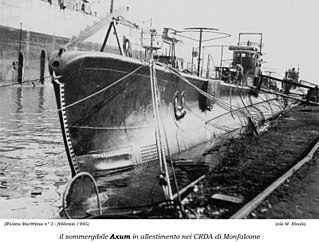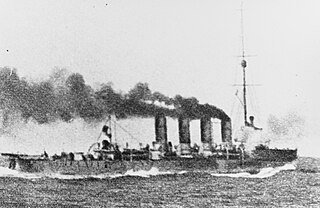
A warship or combatant ship is a naval ship that is built and primarily intended for naval warfare. Usually they belong to the armed forces of a state. As well as being armed, warships are designed to withstand damage and are typically faster and more maneuverable than merchant ships. Unlike a merchant ship, which carries cargo, a warship typically carries only weapons, ammunition and supplies for its crew. Warships usually belong to a navy, though they have also been operated by individuals, cooperatives and corporations.

USS Albacore (SS-218) was a Gato-class submarine which served in the Pacific Theater of Operations during World War II, winning the Presidential Unit Citation and nine battle stars for her service. During the war, she was credited with sinking 13 Japanese ships and damaging another five; not all of these credits were confirmed by postwar Joint Army–Navy Assessment Committee (JANAC) accounting. She also holds the distinction of sinking the highest warship tonnage of any U.S. submarine. She was lost in 1944, probably sunk by a mine off northern Hokkaidō on 7 November.

Operation Pedestal, known in Malta as Il-Konvoj ta' Santa Marija, was a British operation to carry supplies to the island of Malta in August 1942, during the Second World War.

The Romanian Naval Forces is the principal naval branch of the Romanian Armed Forces and operates in the Black Sea and on the Danube. It traces its history back to 1860.

Italian submarine Axum was an Adua-class submarine built in the 1930s, serving in the Regia Marina during World War II. She was named after an ancient city of Axum in Ethiopia.

Italian submarine Alagi was an Adua-class submarine built in 1930s serving in the Regia Marina during World War II. She was named after the Amba Alagi mountain in Ethiopia.

I-58 was a Japanese B3 type cruiser submarine that served in the final year of World War II. Her only significant wartime success came with a conventional torpedo attack upon USS Indianapolis on 30 July 1945. She was modified to carry Kaiten manned torpedoes, making several attacks that inflicted minor damage in exchange for every Kaiten launched being sunk. The submarine surrendered in September 1945, and was later scuttled by the United States Navy.

HMS Safari was a third batch S-class submarine built for the Royal Navy during World War II. Commissioned in 1942, she was assigned to operate in the Mediterranean Sea. During the course of the war, Safari sank twenty-five ships, most of which were Italian.

Operation Vigorous was a British operation during the Second World War, to escort supply convoy MW11 from the eastern Mediterranean to Malta, which took place from 11 to 16 June 1942. Vigorous was part of Operation Julius, a simultaneous operation with Operation Harpoon from Gibraltar and supporting operations. Sub-convoy MW11c sailed from Port Said (Egypt) on 11 June, to tempt the Italian battlefleet to sail early, use up fuel and be exposed to submarine and air attack. MW11a and MW11b sailed next day from Haifa, Port Said and Alexandria; one ship was sent back because of defects. Italian and German (Axis) aircraft attacked MW11c on 12 June and a damaged ship was diverted to Tobruk, just east of Gazala. The merchant ships and escorts rendezvoused on 13 June. The British plans were revealed unwittingly to the Axis by the US Military Attaché in Egypt, Colonel Bonner Fellers, who reported to Washington, D.C. in "Black"-coded wireless messages; it was later discovered that the Black Code had been broken by the Servizio Informazioni Militare.

The Adriatic Campaign of World War I was a naval campaign fought between the Central Powers and the Mediterranean squadrons of Great Britain, France, the Kingdom of Italy, Australia, and the United States.

The Battle of the Strait of Otranto of 1917 was the result of an Austro-Hungarian raid on the Otranto Barrage, an Allied naval blockade of the Strait of Otranto. The battle took place on 15 May 1917, and was the largest surface action in the Adriatic Sea during World War I. The Otranto Barrage was a fixed barrier, composed of lightly armed drifters with anti-submarine nets coupled with minefields and supported by Allied naval patrols.

The Adriatic campaign of World War II was a minor naval campaign fought during World War II between the Greek, Yugoslavian and Italian navies, the Kriegsmarine, and the Mediterranean squadrons of the United Kingdom, France, and the Yugoslav Partisan naval forces. Considered a somewhat insignificant part of the naval warfare in World War II, it nonetheless saw interesting developments, given the specificity of the Dalmatian coastline.
Piero Foscari was an Italian merchant ship and then auxiliary cruiser of the Regia Marina.

Ostro was one of eight Turbine-class destroyers built for the Regia Marina during the 1920s. She was named after a southerly wind, Ostro, common in the Mediterranean and Adriatic. The ship played a minor role in the Spanish Civil War of 1936–1937, supporting the Nationalists.

Freccia was the lead ship of her class of four destroyers built for the Regia Marina in the early 1930s. Completed in 1931, she served in World War II and previous conflicts.
Hokkai Maru was a Kinai Maru-class auxiliary transport of the Imperial Japanese Navy during World War II. She participated in the Japanese occupation of British Borneo and was part of ill-fated convoy HI-71.

Pegaso was a torpedo boat and an escort aviso of the Italian Regia Marina. She was one of the most successful Axis anti-submarine warships of World War II.

The Italian torpedo boat Sagittario was a Spica-class torpedo boat built for the Regia Marina in 1936. During the Battle of the Mediterranean, in the Second World War, Sagittario was involved in several convoy missions, the most notable that known as the "Sagittario convoy", in the course of the Battle of Crete, for which her commander, Giuseppe Cigala Fulgosi, was awarded the Gold Medal of Military Valour. Sagittario survived the war. Re-classified as corvette in 1949, she was scrapped in 1964.
Barletta was an Italian cargo liner built during the 1930s and later became an auxiliary cruiser of the Regia Marina during World War II.



















